Vickers Wellington HX737, Donegal
Early on the morning of Sunday, 28th February 1943, the people
of the Falcarragh area in County Donegal were preparing to go to
mass and could hear the sound of an aircraft circling around the
area. It would later be reported that an aircraft had crashed in
the area known as Meenderry or Meandarragh, a short distance
inland from the town of Falcarragh. The crash location was among
turf banks in the townlands of Tullaghobegley Irish and
Sruhanreagh.
The summary report filed on the first of March reported that
there had been no prior reports of movements of the aircraft
until it was heard over falcarragh by locals. It was
typical in the case of a crashed aircraft that it would have
been heard or observed by Irish Army and police stations as it
passed over the coast or moved around the coast. In
particular the Coast Watchers on duty at the Look Out Posts must
not have at that stage anyway, reported any aircraft movement
thought to relate to the aircraft. This is strange because
the crash site is a relatively short distance from two such
LOP's, No. 76 at Bloody Foreland and No. 77 at Horn Head.
Perhaps reports were received in the days after but they are not
recorded in the crash file, and the LOP log books would need to
be investigated.
The Irish Army report into the crash is very sparse in details
due to the nature of the crash. Among the small number of
reports submitted was this from Commandant J Power, officer
commanding the G2 section of Western Command.
“A British Wellington Bomber crashed
at Falcaragh at approximately 09:15 hours on 28th February,
1943. The aircraft was completely destroyed and the crew of
six were killed. The remains of four bodies were recovered
from the wreckage, on the date of the crash, and the other
two on the following day. The bodies were so terribly
mutilated and burned that it was found necessary to procure
chests and sheets in which the remains might be placed in
order to hide then from the public eye while being recovered
to Rockhill and until suitable coffins could be obtained.
When the military arrived on the scene they found that
the I.B.F. were on guard there and had done excellent work
in the recovery of the bodies. Mr O’Boyle the District Staff
Officer I.B.F. was in charge of the Party there. He had his
men to the scene of the crash in cars hired from Mr Mr
Michael Mulhern, Gortahork. He also purchased a bottle
of Whiskey as stimulant for the men employed at the gruesome
work. Another bottle of Whiskey was supplied by the
O/C., 17 Battalion for those working at the coffining of the
remains that evening.
As the crew of the Wellington is usually six a search
was made in the locality for the missing pair in case they
might be at large. An effort was also made to dig under the
nose of the plane which was buried deep in the bog and to
ascertain if they were underneath. This proved unsuccessful
that evening.
On the following day (1st March) a party left Rockhill
to continue the search at the scene of the crash. They found
the other two bodies, burned beyond all recon ignition, and
buried deep in the bog. The same procedure as used on the
previous day had to be adopted and two further bottles of
Whiskey were purchased for those engaged in the recovery
and collection of the remains.
The task all through was a most gruesome one and the
O/C., 17th Battalion and the men who carried out the job
deserve much credit for the manner in which it was
completed.
The names of the four members of the crew who were
identified were:
1. No:
1051848 Sgt Cambell,
J.C.
2. No: 1213640 Sgt
Court, L.A.
3. No: 11440165 Sgt
Wall,
4. No: 1333354 Sgt
Gutterridge.
”
On the 22nd of March 1943 Captain M Cumisky of the Irish Air
Corps submitted a memo to the Quarter Master General of the
Department of Defence with the details of the efforts taken by
Army and Air Corps personnel at the site of the crash.
I have the honor to submit report in
connection with above mentioned crash.
The aircraft was a Wellington MK. 1 aircraft fitted with
Pegasus Engines. It appears to have dived steeply into a bog
and was completely burned out and destroyed. The crew of six
were killed. The engines of the aircraft couldn't be seen
but several separate cylinders were lying around. 4 Browning
Machine Guns and 2 Vickers K. Machine Guns, all serviceable,
were collected as well as about two hundred rounds of
ammunition, all damaged. About two tons of scrap was loaded
on the trailer and the remainder was dumped into the hole
dug by the crash and buried there.
It was learned that the owner of the property was a Mr
Philip Duggen of Lower Bealtoray, Cortahork, Co. Donegal and
that, due to illness he had not been near the scene of the
crash and would there fore have had little extent of the
damage caused. The remainder of the engines were embedded in
the face of the trench recently dug for cutting turf and the
presence of scrap would render it impossible to cut any more
turf from a thirty foot length of this face. It is
considered by the salvage Officer that £10 or £15 would
compensate the owner for the loss of turf from this part of
the bog.
Personnel Employed
One Officer - 3 days
One N.C.O. - 3 days
7 Men - 3 days
3 N.C.Os and 7 men from 17th Battalion for one day.
Details of transport used will be
submitted later on approved pro-forma.
In a related but separate report, Cumisky mentions that any
scrap from the aircraft was brought back to Baldonnel Aerodrome,
the HQ of the Irish Air Corps.
The Irish officers who attended the scene felt it was important to commend the soldiers and officers of 17th Infantry Battalion who had the task of sifting through the wreckage of the bomber for the remains of the dead airmen. For this reason, three bottle of Whiskey were purchased from the Non Commishioned Officers mess at Rockhill Military Post.
The unit records for 7 (C) OTU do not carry great detail and
the deaths of the crew of HX737 are recorded on just two lines
of the Operations Record Book (ORB) among some mundane
administrative entries. It is unclear based on the
information available in 2025, as to the purpose of the flight
or the take off time. The ORB of 7 (C) OTU as can be seen
below does not contain anything of that nature. At the
time of the crash, the OTU was acting as the capacity of the
station and thus there is no sepatate station ORB with further
details. At this time also in 2025, there is no indication
of a AIR81 Air Ministry casuatly file existing but it is hoped
that this will be revealed in future releases of this file
series.
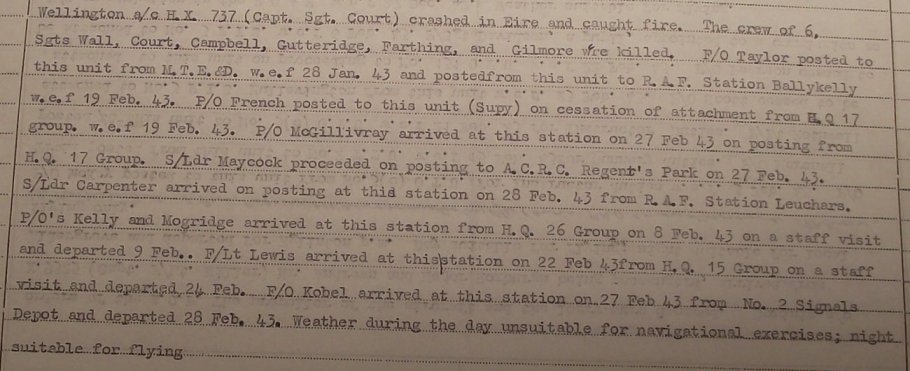
These records are held by the United Kingdom National Archives in Kew, London. It is worth noting that on the day before the crash of HX737, number 7 (C) OTU suffered the loss of another Wellington bomber on a training flight in Scotland. HX779 crashed into a hill side in Kintyre killing Sgt D F Sutterby RCAF, F/Sgt J N Mittom RCAF, Sgt W E Davies RNZAF, Sgt J M Wilson and Sgt H G Brook. Even though the unit was not in combat, the training regime, the weather and the technology of the time took a hefty toll on its trainees.
The only other obvious entry in the ORB relating to the crash is a note that Sgt Gutteridge's funeral took place locally on the 4th of March. The remaining five men were returned to their families for burial across the United Kingdom. Carnmoney Cemetery Belfast were able to say from their records that James Gilmore was buried there on the 3rd of March. His parents are buried with him, having died in 1953 and 1965. John Steen Campbell was also interred in the same cemetery following the crash.
The relatives of the dead airmen have been kind enough to
supply the following information along with the details obtained
from the Commonwealth War Graves Commission website.
The crew were stationed with 7 (Coastal) Operational Training
Unit based at RAF Limavady in Northern Ireland. This training
organization was used to build together crews for Coastal
Command's operational Squadrons. Each member of the crew would
have undertaken their basic service training prior to this
before going on to learn their particular trades at separate
training facilities. It as possible to obtain the men's service
records in 2025 and this revealed that most had only been posted
to the unit on the 5th of January 1943, just weeks before they
died.
Sergeants Court and Wall would have completed their advanced training on single engined aircraft before moving on to a multi engine training unit.
John Campbell is known to have trained to become a navigator in South Africa.
The three remaining men, Farthing, Gutteridge and Gilmore would have learned their trades of air gunners and wireless operators. All would have found themselves posted too 7 (C) OTU where they formed a training crew. All would have therefore been well trained in each others trades and were in the process of becoming a crew. They may have gone on to join one of the RAF’s front line Coastal Command Squadrons flying the Wellington or Halifax patrol bombers.
The aircraft they flew was a Vickers Wellington VIII bomber
built by Vickers at the Weybridge, Surrey factory. It was
delivered to the strength of 32 Maintenance Unit on the 2nd of
September 1942, thence to 33 Maintenance Unit and was delivered
to 7 (C) OTU only on the 9th of February 1943, being with the
unit less than 20 days before the crash.
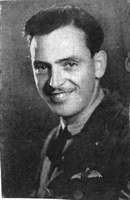 LEONARD ASHBY COURT
Sergeant (Pilot) Royal Air Force Volunteer Reserve Service No:
1213640
LEONARD ASHBY COURT
Sergeant (Pilot) Royal Air Force Volunteer Reserve Service No:
1213640
Leonard was 23 years old at the time of his death, having been
born 1919 to Kate and Leonard A Court. In a sad
forshadowing, Leonards father passed away in 1922 after an
illness. His mother remarried, to Bernard Toms, and they
raised Leonard and his three brothers.
In April 1941, while he was a member of the RAF, he married
Joyce Enid Whiles from Syston.
Killed on Active
Service
Mrs. Court. of Barkby, has received news that her
husband, Sergeant . Pilot Leonard Court, Coastal Command.
R.A.F., has been killed on active service.
The Sergeant-Pilot
was the eldest son of Mr. and Mrs. Toms. of the
Stores, Barkby. Aged 22, he was educated at City Boys'
School, and was well known in Syston district, being
an all round sportsman. He played for Syston Imps
and for Barkby Cricket Club.
He was, before joining the R.A.F., in the
costing department of Messrs. Jones and Shipman. He went
to Canada for the completion of his training.
Leonard's death would sadly, leave his son without a father at
the same age as Leonard himself had. He was buried in
Barkby Cemetery
Photo from Leonards son Ian and his wife Margaret.
 JOHN D'ARCY WALL
Sergeant (Pilot) Royal Air Force Volunteer Reserve Age: 22
Service No: 1140108 Additional information: Son of John D'Arcy
Wall and Mary Elizabeth Wall, of Rochdale; husband of Janet Wall
(nee Baron), of Rochdale.
JOHN D'ARCY WALL
Sergeant (Pilot) Royal Air Force Volunteer Reserve Age: 22
Service No: 1140108 Additional information: Son of John D'Arcy
Wall and Mary Elizabeth Wall, of Rochdale; husband of Janet Wall
(nee Baron), of Rochdale.
Seeking a photo
Sgt Wall had married only in late 1941, to Janet Baron in
Scarborough district, Yorkshire. His father, of the same name,
died on 24th October 1953, with an address at 101 Redcross
Street, Rochdale. His mother Mary Elizabeth (nee Eastham) lived
on until 26 December 1964, living also at the same address. No
next of kin is listed on her probate record. Sgt John D'Arcy
Wall was buried after the crash in his native Rochdale.
The Rochdale Observer published the sad details of his funeral
and life in their 6th March, 1943, edition: Sergeant-Pilot John Darcy Wall, only son of
Mr and Mrs Darcy Wall of 101 Redcross Street, was killed in
Northern Ireland on Sunday last. Twenty-two years of
age, he joined the R.A.F. eighteen months ago, had spent
nearly twelve months in Canada and returned home only at the
end of last year. Before joining the forces he was
employed as an assistant with Mr Robert Sheard, grocer, of
Bury Road, and before that was with Messrs. James Duckworth
and Sons. Fifteen months ago, he married Miss Janet
Baron of Deeplish Road, who is no serving in the
A.T.S. Sergeant-pilot Wall was a member of the Third
Church of Christ Scientists, Smith Street, with which he had
been connected from boyhood. The interment will take
place at Rochdale Cemetery this afternoon."
JOHN STEEN CAMPBELL Sergeant (Nav.) Royal Air Force
Volunteer Reserve Service No: 1081848
Additional information: Age: 34 Son of Samuel and Eleanor (Ellen) Campbell, of Belfast; husband of Emma Campbell, of Belfast. John was born with the registered name of James John Steen Campbell in Belfast in Jun 1908.
He married in October 1942, in Belfast, to Emma Baillie but
just three months later, the Belfast Telegraph on March 2nd,
would be publishing his death notice: MADE SUPREME SACRIFICE. BELFAST AIRMAN. WED
THREE MONTHS AGO Sergt.-Observer John James Steen Campbell,
who was married only three months ago has been killed on
active service. He was formerly a damask designer, and had
been in the R.A.F. about two years. Until his marriage he
resided with his sister, Mrs. E. Haslett, 35 Loopland Drive,
Belfast

Provided by Sam Christie
 RONALD WILLIAM GUTTERIDGE
Sergeant (W.Op./Air Gnr.) Royal Air Force Volunteer Reserve Age:
21 Service No: 1333994
RONALD WILLIAM GUTTERIDGE
Sergeant (W.Op./Air Gnr.) Royal Air Force Volunteer Reserve Age:
21 Service No: 1333994
Ron was the son of Alice and Bertie F W Gutteridge, of
Huntingdon. His father had passed away in 1938.
Photos provided by Ronald's sister Margaret.
Sgt Gutteridge's sister Margaret who was only a young girl of
six at the time of his death sent a number of photos of him. She
was able to learn some more about her older brother through the
letters published in local papers by this researcher as people
from the town came forward with their memories of Ronnie. She
traveled to Northern Ireland on the 50th Anniversary of his
death and was delighted to find his grave well tended. She
planted there some snow drops from her garden as her little
memorial to the brother she barely knew. She recalled how he had
a sweet heart at the time of the crash in Northern Ireland and
that this kind lady wrote to Ronnie's mother for many years
after the war and then in turn to Margaret. The photo below
shows Ronald with his mother and one of his brothers.
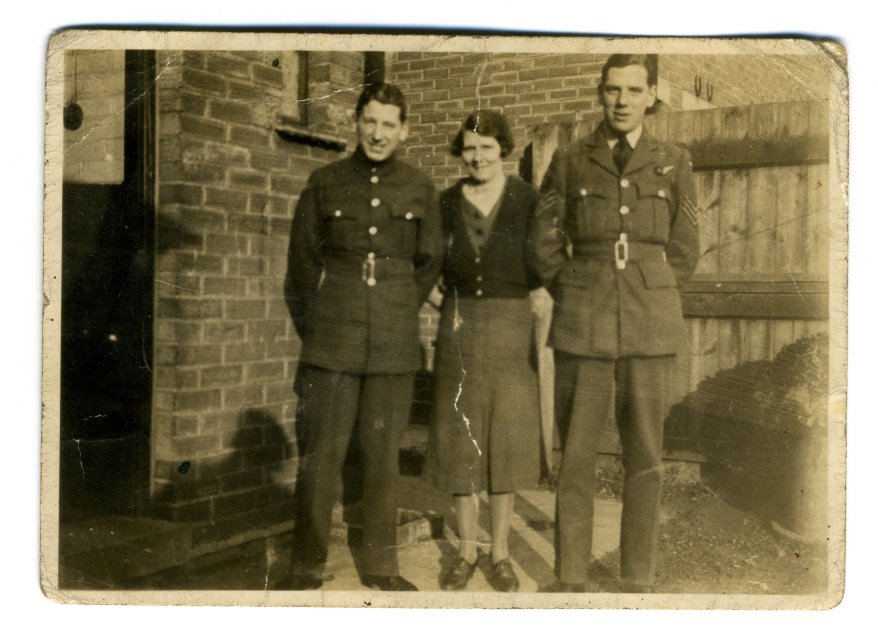
One old friend of Ronnie's was a Jim Newell who wrote: Reference your letter in the Hunts
Post. Ron Gutteridge and I were both employed as
clerks by the Beds Cambs and Hunts Electricity Co., he at
George Street Huntingdon office and myself at St.
Ives. Ron was a lovely easy going lad with a ready
smile and always up for a joke or a simple prank. He
was determined to volunteer as aircrew with the RAF. I
think I only saw him once in uniform and proud of the white
flash in his garry.
Jim Newell also served with the RAF as a wireless operator but
had to his mind never known what had befallen his old friend
Ron. Through his having written his letter, he was able to
make contact with Margaret, Ron's sister and they met and he was
able to tell him more first hand details of her big brother.
Margaret herself passed away in 2022.
JAMES GILMORE Sergeant (W. Op./Air Gnr.) Royal Air Force
Volunteer Reserve Service No: 1036700 Additional Information:
(From Headstone) Aged 23, Son of Jane and John Gilmore.

Kindly provided by D Quinn, nephew of James's sister Betty.
GEOFFREY JAMES SCOTT FARTHING Sergeant (W.Op./Air Gnr.)
Royal Air Force Volunteer Reserve Age: 21 Service No: 1315164
Additional information: Son of William Scott Farthing and Alice
Farthing, of 22 Aycliffe Road, Hammersmith and later Caversham,
Reading. Berkshire. Brother of Berie Leslie Scott Farthing.
Seeking a photo 
Geoffrey James Scott Farthing, the family in some records going
by the surname 'Scott-Farthing' was son of William and Alice
Scott Farthing. He had one brother named Berie Leslie Scott
Farthing, named Leslie in his 1945 marriage announcement to Dona
Cerie Owen from Holyhead. The boys parents address was listed in
1945 as 53 Priest Hill, Caversham. Leslie Scott-Farthing passed
away in 1977.
If any one reading this might have any knowledge of, or photos of Sgt's Wall and Farthing, I would love to hear from you. It has proved impossible so far to contact any relatives.
On Monday the 28th of February 1949, the Belfast Telegraph
published three small memorial notices, two for Sgt Campbell
from his brother Cecil and sister Edith and her family, and a
third memorial for James Gilmore from his parents at 21
Newington Street.
Local Historian John Connaghan was very helpful with this report by visiting the crash site and providing the following photos from the crash site in the bog. As can be seen the area is rather flat.
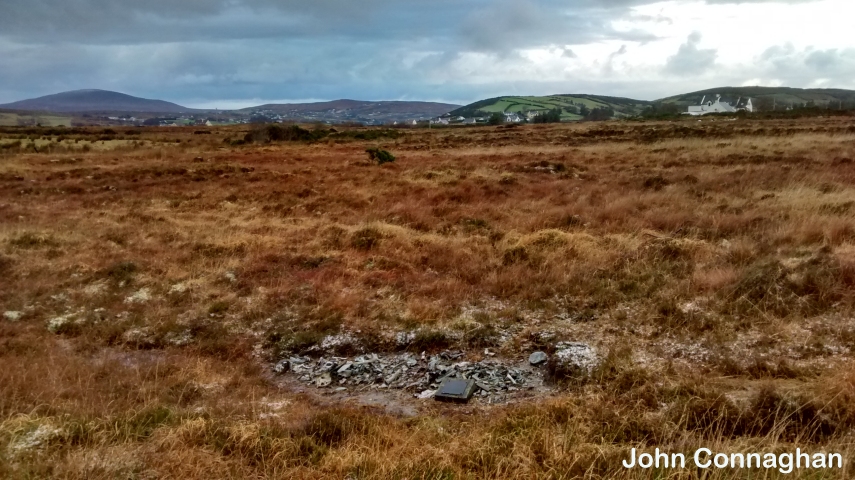
The photo above is taken at the crash site, note the memorial plaque in the foreground. This view is taken facing roughly north.

The image above is taken facing to the south in direction the aircraft is understood to have been flying. In the background can be seen the peaks at Mount Erigal.
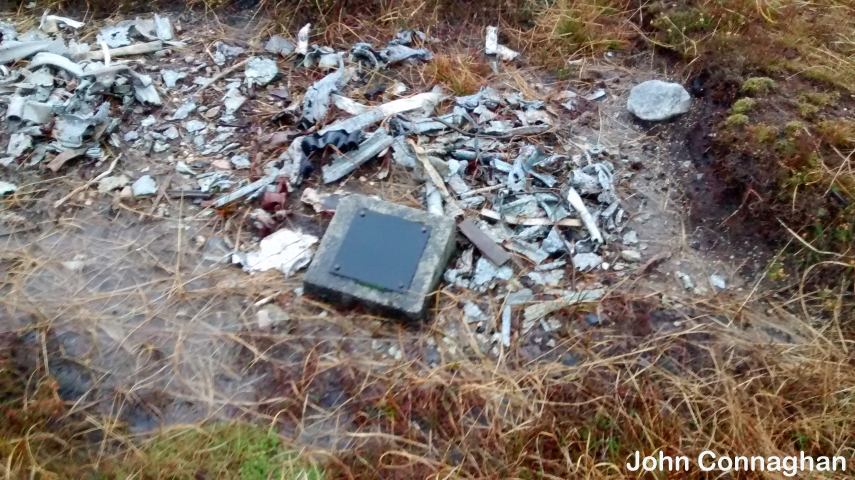
At the crashsite, the patch of ground is scattered with
assorted shattered remains from the aircraft.
